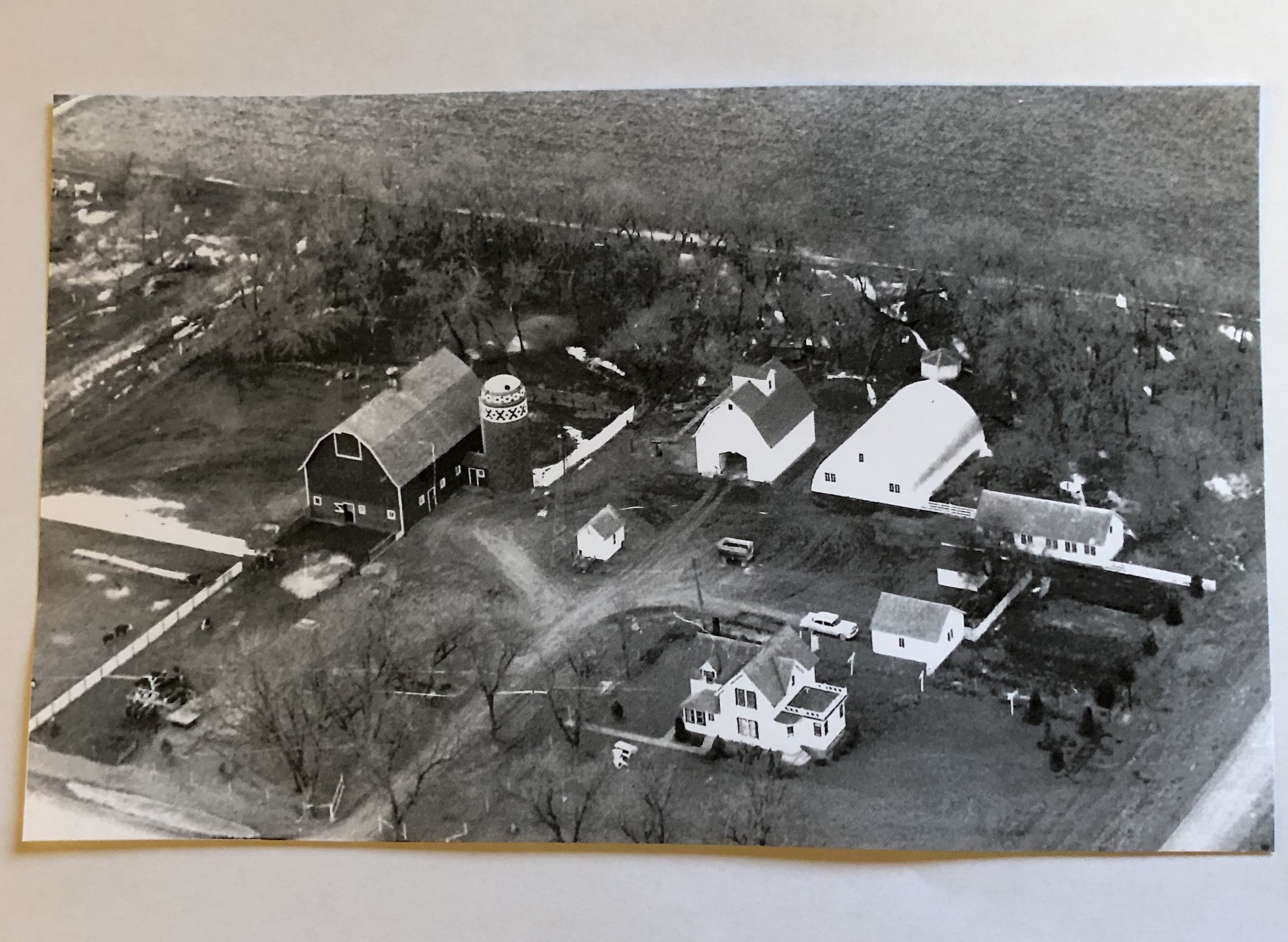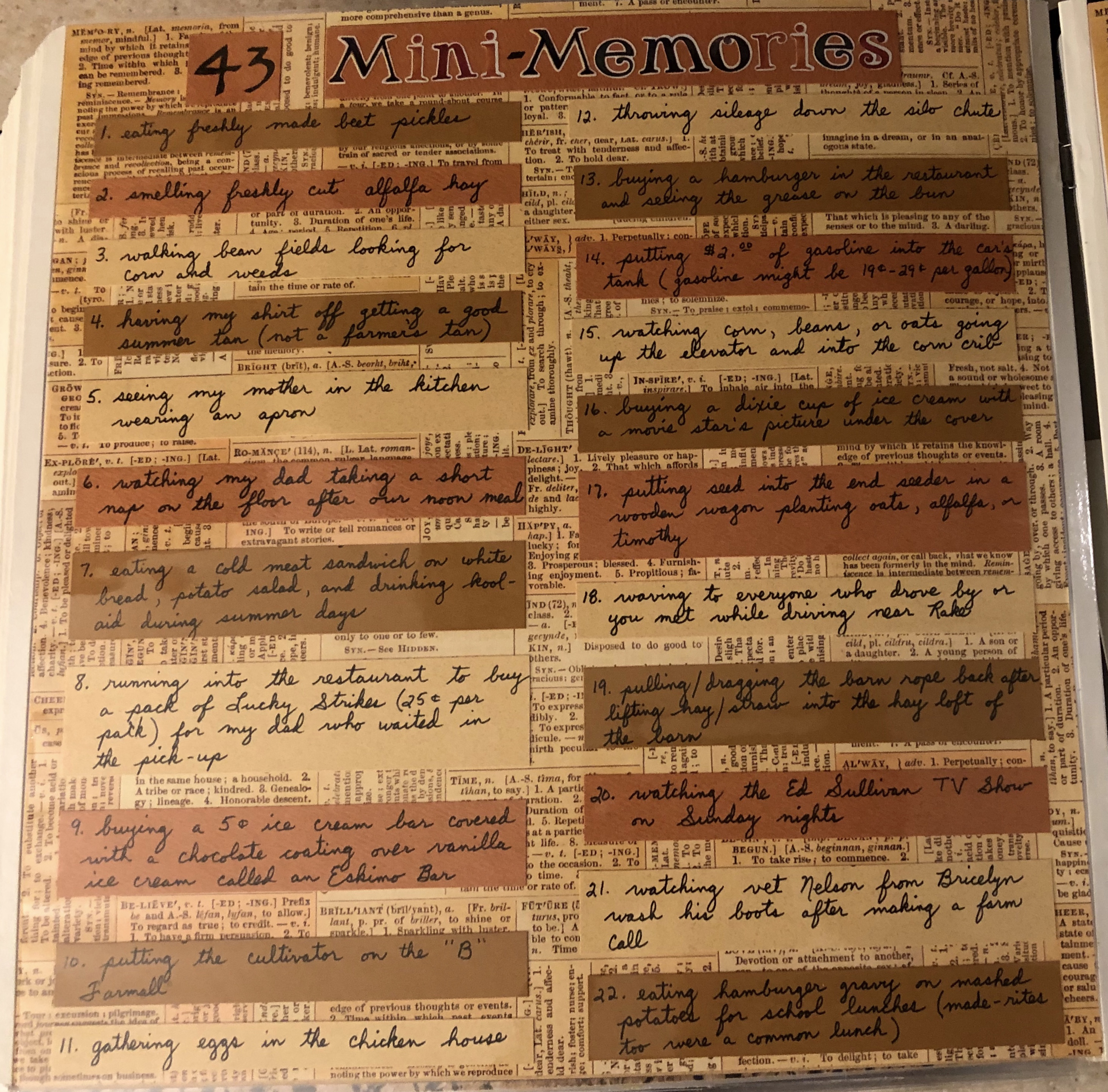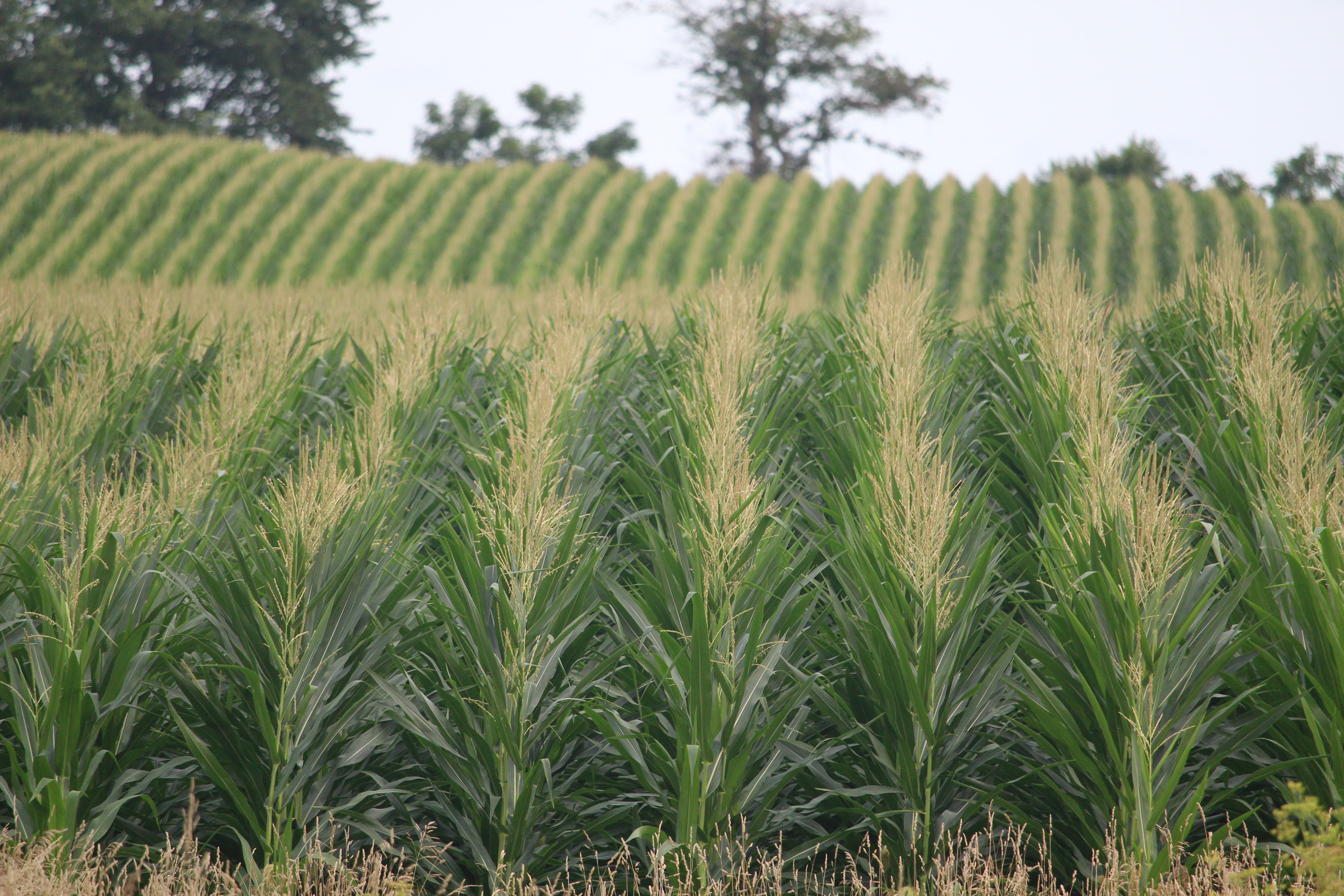The farm where John Teigland was raised straddled the Iowa/Minnesota stateline gravel road one mile north of Rake, Iowa. He graduated from Rake High School in 1961 with a class of thirteen, then went on to graduate from Waldorf Junior College in Forest City, Iowa, and Mankato State University in Mankato, Minnesota, where he earned a degree in elementary education. He taught sixth grade for part of a year in Madelia, Minnesota, and then for 33 years in Hastings, Minnesota. He spent many summers working for Jacques Seed Company in Prescott, Wisconsin, and then Mycogen Seeds located a few miles south of Hastings. John and his sister, Janice, along with their respective spouses, Mary and Don, still have the family farm, but all of the buildings are gone as a result of two separate tornadoes hitting the farm on April 2, 1967, and early September, 1985. The following vignettes are a glimpse into his boyhood days on the farm.
Winter
Each season of the year had its unique activities for someone growing up and experiencing rural life in the Midwest. Winter was one tough season to endure year after year on the farm. There seemed to be more snowstorms back then, and we could have blizzards which would last two or three days. We would be snowed-in during this time with the roads blocked by huge snow drifts. When the blizzard would finally clear, the only thing we could do would be to wait for the snowplow to come by and open up the road. You could often hear the plow before you saw it, because it would be working hard to plow through the drifts. My wife Mary’s grandfather, Fred Havnen, drove the Caterpillar snowplow. The big drifts in the road nearest to the farm would be just west of the farm buildings. It would not be unusual for that area to have eight to ten foot high drifts. The plow would hit the drift and then back up to hit it again and again. The drifts in and around the farm buildings would be so hard that you could walk on top of them or tunnel into them to make snow forts. We had a snow bucket on the Farmall M for trying to open up the farmyard. When the wind blew, it was a case of not being able to see the barn as one looked out the windows of the house. I would turn on the yard light to see how bad it was outside. The question would always be: “I wonder if there will be school tomorrow?” The morning after the wind quit blowing always seemed crystal clear, and it was fun to see what nature had created in the white winter wonderland.

The Farmstead, North of Rake, Iowa, where John Teigland grew up
Winter was hard on the animals, and they did not gain a lot of weight during the winter. They ate to survive the cold. We had tank heaters to keep the watering troughs open in the various buildings or the outside tank. When all the animals were in the barn, it was surprisingly warm, as all the animals gave off heat. It was tough doing chores in the cold. The hay mow was full of hay and straw, and you would throw it down a hay or straw chute in the barn.
Tryg Havnen would bring out his portable feed grinder, which was mounted on a truck, and we would grind feed, mostly corn. The joke was that Tryg held his grinder together with baling wire, but it never seemed to break down. Oftentimes the ground corn was stored in a wagon and you took out what you needed morning and evening. The whole ear of corn was ground for the cattle. Pigs would have other things mixed into their feed, including a feed called “Mormans,” to add nutrients. Chickens were different. By the chicken house there was a smaller building, called a feed house, to store the chicken feed. We always tried to keep all the animals and equipment inside some type of building.
I spent winter hours listening to the games of the Minneapolis Lakers, Minnesota’s only pro sports team, on the radio and keeping track of individual statistics of the basketball games upstairs in my room during the evenings when I was young.
I also spent much time sitting on the kitchen floor in front of a heat register with my back against the kitchen stove. It was nice and warm as there was constant heat coming out of the register from the wood-burning furnace. We had filled part of the basement with wood, corn cobs, and coal in three separate bins late in the fall. The basement was a very good place for mice to have a home. We always had mouse traps set!
We also played ice hockey in Rake! Harris Lee, who was the bookkeeper at the Rake elevator, had moved to Rake from Duluth and had a large family of boys. Harris had played hockey and always made a large outdoor rink, but he also had a dream of building an indoor rink. Eventually, his dream came true with a lot of volunteer help. The building looked like a large machine shed and had no seating, but Rake had one of only four indoor rinks in Iowa at this time. Prior to this, we played boot hockey on the frozen water in the dredge (small creek) south of the farm buildings with a rock and a tree branch shaped something like a hockey stick. We also played the game at recess on the side of the school. There were many bruised legs as we swung tree branches at our Lee blue jeans. I don’t think anyone could get the rock off the ice. As the winter winds began to warm, we always looked forward to spring.

A Page from John Teigland’s memory book
Spring
Spring was a welcomed relief from the long, hard winter. The warm southern breezes arrived, along with mud, before the ground had a chance to dry up from the melting snow. One of the first things that had to be done was to get all the manure hauled out onto the fields. Certain parts of the barn were cleaned regularly, and the manure was put into a pile on the north side of the barn. There was a metal track suspended from the barn ceiling with a rectangular-shaped bucket with straight sides and a curved bottom into which the manure was shoveled. When the bucket was full, you pushed it by hand as it continued along the track. Once you reached outside the barn, the track was held up by tall poles and there was room to dump your load of manure by “tripping” the bucket. We especially did this procedure when we had milking cows. In the spring you used a tractor and a loader (a smaller version of the snow bucket) and loaded the manure up to be hauled out to the fields. You always checked what direction the wind was blowing from before you started spreading the manure so you, as the driver, would not get peppered with manure. The rest of the manure had to be pitched out of the barn by hand using a pitchfork. The barn always looked so different once all the manure was cleaned out. Pitching manure all day long was no picnic, and the only pay was self-satisfaction in getting the job done. Your clothes did not smell the greatest afterward!
There was something special about the grass greening up in the farmyard in spring. The area we did not mow—where we would turn the sheep onto for their first taste of green grass after a winter of eating hay—was usually bright in color with the fresh green grass and yellow dandelions standing out. After these yellow flowers turned to white puffs full of seeds, the area looked entirely different. Before the grass turned green, we had gotten our new baby chicks for the year. They were put in a portable breeder house in the middle of the farmyard with a heating unit to keep them warm. We would move them out to the pasture in late spring or very early summer.
The farm crops were planted in the spring. The grain crops were sown or drilled in as soon as you could get into the fields. Corn and soybeans were planted in the first days of May. I remember one year my dad was planting corn on the Iowa side. It was early morning, and my job was to take the pickup (this was before I was old enough to have a driver’s license) and haul feed and water out to the chicks in the pasture. The young chicks now had small feathers instead of the peach fuzz they had when we brought them home from the hatchery in Bricelyn, Minnesota. On the way back from feeding the chicks, I pushed the pickup’s accelerator to the floor (kids liked to say “floored it”), where it stuck. I reached down to pull up the accelerator, which was not too smart on my part! Boom! The pick-up hit the rotary hoe that was sitting in the pasture by the road, waiting to be used when the corn first came poking up through the ground. I did not get hurt, but the tire on the pickup was ruined. My dad was at the end of the cornfield to the east putting more seed into the planter. He came running and was not too happy!
After alfalfa had been a hay crop for a few years, it was plowed up and rotated with another crop. Alfalfa had very long roots, and it was very tough to plow the ground. One year, Dean Loge (my sister’s first husband who died of cancer at an early age), my dad, and I were plowing. I was driving a John Deere 50, pulling my dad’s Farmall M and a 3-bottom plow by using two log chains and an old car tire to give some absorption between the two tractors. We set the back tires on the tractors very close together to give the tractor more pulling power. As my dad and I were turning in the south end of the field on the town side by the dredge, my tractor’s back tire ran over a big rock I did not see hidden in the grass. My tractor started tipping over slowly. I stood up and jumped and luckily was able to clear the tractor as it rolled over. We stayed pretty calm, but I remember my dad saying, “Don’t tell your mother what happened!” Amazingly, there was very little damage to the John Deere.
Memorial Day was May 30th, and it seemed to be the bridge between spring and summer. School was out, so our upcoming summer vacation had started.
Summer
It seemed like summer was the most relaxing season, yet we were very busy with farming activities. Thunderstorms were as much a part of summer as blizzards were a part of winter. We had a pasture of about five acres on the Iowa side, down by the dredge. Cattle, which were put in the pasture, had no shelter other than the trees by the dredge. After one storm, we went down to the pasture the next morning to check on them. Four of the cattle lay on their backs with all four legs sticking straight up into the air. They had been struck by lightning. Another one was missing, never to be found again. Apparently, it was struck by lightning, but it was not killed. It took off running and the fence could not hold it in. It might have run itself to death.
Sometimes during the summer, if the cattle were grazing on alfalfa, you had to be careful that they did not eat too much and end up bloating. A bloated cow or sheep looked like a balloon with legs. I remember my dad would stick a piece of wood crossways into an animal’s mouth to bite on, and then he might stick a knife into the high sides of the bloated stomach by the hind legs. Gas and green grass would come shooting out of the puncture wound from the knife. Sometimes the animal died if you did not do anything to help the situation.
Baling hay and cultivating corn and beans were big summertime activities. When baling hay, there was always a sense of timing to cut it, let it dry, rake it, and bale it before too much rain fell on it. A little rain did not hurt after you had it cut, but too much rain almost turned the green hay to a brown color and left no leaves on the stalks. After it was baled, you had to move it tothe barn to be put up into the hay mow. Before we began baling hay, we put it into the hay mow as loose hay, which always seemed like a less efficient method to me, even as a youngster. My jobs during haying varied greatly depending on my age, but I remember pulling the big barn rope back after the bundle of hay had been pulled off the hay wagon and into the barn. When we had rectangular-shaped bales, we used an elevator to put the hay bales into the hay mow. There was no better smell than freshly mowed hay from the field or in the barn.
I learned to cultivate corn as a young boy (maybe about 12). At first, we cultivated the corn two ways because corn was checked during planting. My first experience was cultivating going crossways. This was usually the second time for cultivating the corn during the summer. If the checking had worked properly during planting, it was easy to cultivate going crossways, but if the corn stalks did not line up properly, it was a nightmare. Cultivating corn usually came to an end the first part of July, and the last time through the cornfield was called “laying it by.” The corn should be at least “knee-high by the 4th of July.” Trying to cultivate the corn after that resulted in breaking off the corn stalks near the ground. I learned to cultivate with a two-row mounted cultivator on a Farmall B.
Late summer meant it was time to combine oats and bale straw from the grain for the upcoming winter months. Levi Loge, who lived 1 ¼ miles north of us, was a farmer who exchanged work with my dad during combining and baling. I would go to his place and help by hauling the combined oats in a wagon hitched to a tractor. During the late summer, we would also “walk the beans,” hoeing out Canadian thistles, cockleburrs, milk-weeds, and volunteer corn (corn from last year’s corn crop in that field which had fallen off the corn stalks). Hoeing out thistles could be hard work. It was sometimes almost easier to wear leather gloves and pull the thistles out. Once in a while, my dad would hire some teenage girls from Rake to do this work. Mary Ann (my eventual wife) was part of this group, and I remember she would turn “brown as a berry.” By the third week of August, we all knew school was right around the corner and summer was quickly drawing to a close.
Fall
September 1st marked the beginning of fall activities on the farm. Filling the silo was one of the first tasks on the agenda. Neighbors would help each other by providing a tractor to pull the wagon loads of silage from the field to the silo blower standing next to the silo. The Hauskins and Jordahls had all the silo filling equipment. I always enjoyed rushing home from school to watch the whole operation. It was a dangerous job. Fritz Jordahl lost an arm during this time on someone’s farm. My dad, Ben, had all of his clothes twisted off. He had a new pair of bib overalls that had not been washed yet. The power take-off between the tractor and the silage wagon had a bolt sticking out of it. The bolt caught in the hammer’s loop of my dad’s bib overalls. My dad held onto the front end of the silage wagon as his clothes were being twisted off, including his underwear. All Dad had left on were his shoes and shirt collar. No one happened to walk by the silage machine, and the tractor made too much noise for anyone to hear my dad yelling to shut off the tractor. He could not let go until all his clothes had twisted off. I remember coming home from school and seeing all the twisted shreds of clothing in a pile in the pump house. My dad was ok, but he was severely bruised as a result.
In the early fall, the baby chicks, which by now were young hens, were brought in from the pasture to become “laying hens” and kept in the chicken house. This was done at night and the young hens were caught by hand as they roosted in an open-air portable building in the pasture. The man running the hatchery came and cut off a part of each hen’s upper beak with a special apparatus that had a hot piece of metal. This was done to prevent the chickens from pecking each other because they were not used to being confined to a small area after spending the summer roaming in the pasture. As I look back on this, it seemed rather cruel to “debeak” each hen, but they could kill each other by pecking at one another. The hen house always looked so clean at this time, with ground-up corn cobs on the floor, and it was disinfected with a white substance on the walls, ceiling, and floor that left a pungent odor. The hens were now ready to provide our family with “egg money” to buy groceries.
My dad and I did not hunt, but I can remember Saturdays in the fall when hunters came from the Twin Cities or surrounding towns to hunt pheasants. You could usually tell if the hunters were not from the immediate area because they did not know which side of the stateline gravel road that we lived on was Minnesota or Iowa. There were sometimes gunshots from the wrong side of the road because the hunting season did not start at the same time in the two states. The hunters were usually good about asking permission to hunt on our land, and we never had a farm animal accidentally killed in our pasture during hunting season. My sister’s husband, Dean Loge, had relatives who came from the Twin Cities and hunted on their farm near Pilot Grove, Minnesota. They always came with a lot of candy in the trunk of their car.
During corn-picking time, I had to help unload the wagon loads of ear corn into the elevator leading up into the corn crib. I always thought it was a big deal when a farmer came to our farm with a mounted picker and was hired to “open up” a cornfield so we could use our two row New Idea pull-type picker and begin picking corn. My dad eventually bought a mounted picker himself. Picking corn was in high gear around Halloween time. It was special to see the dried corn leaves blowing around with the tree leaves. The bull thistles seemed to be standing alone in the pasture as the grass had been chewed close to the ground by this time. The bull thistles had survived into the fall. The frosty nights were accompanied with special sights, especially during a harvest moon. Winter was just around the corner. The theater of seasons had made a complete circle.

Photo by Jon Andelson


